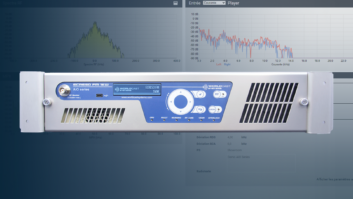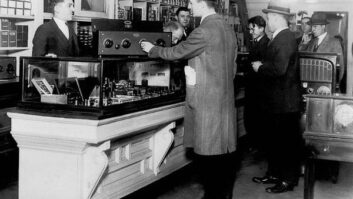
Since 1969 the Electro-Voice RE20 has been a staple of radio and recording studios. It’s a favorite for air and V/O work as well as for recording drums, bass amps and horns. The RE27, introduced in 1989, was an upgraded design, featuring a neodymium magnet and sleeker look. It packed a bit more punch but with a somewhat brighter sound, and added an extra roll-off filter.
Recently Electro-Voice introduced the latest in its RE line, the RE320 — not intended to replace these studio workhorses but to present a new take on those proven designs.
What sets it apart from the venerable RE20? The most obvious difference is the color. The battleship gray of the RE20 and the brushed nickel of the RE27 have been supplanted by a jet-black finish that retains the RE20 grille design.
New and old
This is still a cardioid large-diaphragm dynamic mic. It still uses humbucking coil technology to protect against EMI. It still uses the neodymium magnet technology of the RE27, but with a re-engineered diaphragm for better transient response.

Midday talent Beth Bacall with the new EV model.
It also features Electro-Voice’s Variable-D pattern control, introduced back in the 1960s with mics like the RE15. This solution, according to EV, is designed to minimize tonal changes associated with proximity effect and with sources moving off-axis. It’s intended to provide a predictable frequency response even if the source is moving around the mic.
Beyond a different color, you’ll the frequency response contour switch. This takes the place of the usual bass roll-off switch found on the RE20 and gives the mic what EV calls “Dual Personality.” Rather than providing a choice between a flat response and a bass roll-off, this provides a choice between a flat response and a “kick” curve, tailored for use with bass drums. It actually boosts the low end slightly while providing a 4.5 dB midrange dip centered around 380 Hz, along with some high-end “air” boost. According to the spec sheet, it also extends the low frequency response from 45 Hz down to 30 Hz. The drawback to this design is that it does away entirely with the traditional bass roll-off, which some users may still require.It would have been nice if they could have retained a roll-off switch in addition to the contour switch.
Mellow
For radio, the obvious application is voice.
I immediately set about testing the RE320 by replacing the RE20 in our production studio. It was connected to our console via a Symetrix 628 voice processor. I turned one of our production engineers loose with some commercial copy.
Using the same presets we used for the RE20 (compression, EQ, etc.), he immediately fell in love with it. Next I introduced it to our on-air studio. The general consensus was that it had a mellower sound than the RE27 we normally use. It was tested using a Symetrix 628 and an Aphex 230.

Johnny Stone is PD and morning host. He still gives the nod to the RE27.
In both cases, the brighter high end of the RE27 was evident compared to the RE320, almost to the point of sounding brittle. The operators also suggested that they didn’t have to work as close to the mic when using the RE320, a testament to its improved Variable-D performance.
Our midday hostess, Beth Bacall, loved it. She raised quite a fuss when I had to take it back. Program director and morning show host Johnny Stone was ready to approve the purchase of one once he tried it, though he still preferred the RE27. He chalked that up to being accustomed to the latter’s sound.
On vocals, the mic lends itself easily to providing more girth to a voice that might be lacking bottom end, such as a female voice. If the voice is already deep, the reduced proximity effect in the RE320’s design takes the excessive “boom” out while still keeping things warm-sounding.
Thunderous
Next, I tried the mic on a few other sources more likely to be found in a home or professional recording studio.
On bass amp, the result was absolutely thunderous. Buckets of low end while still preserving the snap of the strings. I found myself deleting takes that were previously recorded direct through my favorite tube preamp in favor of the RE320 going into a solid-state preamp. On a guitar amp, the RE320’s performance seemed to rely more heavily on placement. Aiming it toward the outer half of the speaker cone sounded too mellow for my taste, almost muddy. But placing it dead center, aimed straight into the voice coil, yielded very satisfying results.

Compared to the Shure SM57, a mainstay of guitar amp recording, the sound had more body. While the SM57 gave plenty of bite, it almost seemed shrill in comparison.
Finally, I tried it on bass drum. The “kick curve” feature worked as advertised. It was hard to find a placement that didn’t work in some way or another, but the best result was found simply putting it a few inches from the rim, aimed right at the point where the beater meets the head. Running it flat gave a very usable result, but it still had me reaching for the EQ. Engaging the contour switch saved me the trouble.
Could I have still tweaked it? Sure, if I wanted to; but I didn’t want to. The kick drum had a tight, punchy sound that sat well in the mix.
As an engineer, I’m intimately familiar with the old saw “If it ain’t broke, don’t fix it.” One could be forgiven for wondering why Electro-Voice would mess with such a time-tested design as the RE20.
PRODUCT CAPSULE
Electro-Voice RE320 Microphone
Thumbs Up
+Sounds good on more than just voice
+“Kick curve” useful
+Good-looking
Thumbs Down
-No bass roll-off
Price: $499.95
For information, contact Electro-Voice at (800) 392-3497 or visit www.electrovoice.com.
Other engineers and DJs say the introduction of the earlier RE27 was met with divided opinions. Some loved it, others continued to swear by the RE20.
The RE320 seems to deliver the best of both designs. Overall, I thought it sounded great on just about everything I used it. It’s well built and good looking. I even like the new design of the included case.
Is it good enough to serve as your main on-air or production mic?If the lack of a bass roll-off switch isn’t an issue, absolutely.Most outboard mic processors include a roll-off control anyway.
Could it potentially replace your trusty RE20 or RE27?I thought it sounded better than both, but that comes down to personal taste.Think of it as another color in your audio palette. But the street price of around $299 makes it much less expensive than its predecessors and easily within the reach of freelance VO artists and home recording studios. It’s worth every penny. Do I have to give it back?
Curt Yengst, CSRE, is assistant engineer at WAWZ, Zarephath, N.J.












